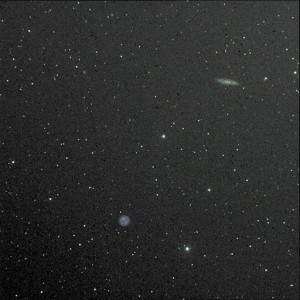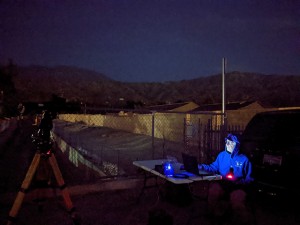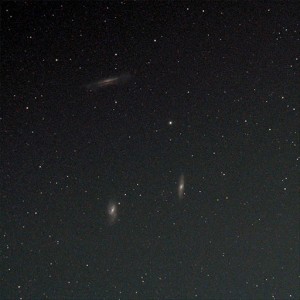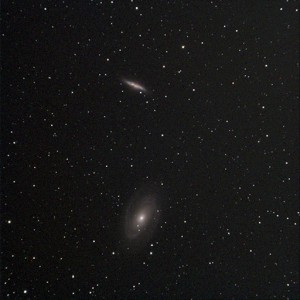Normally I wouldn’t even have considered trying this project. I’m known for hauling my telescopes to a dark sky site in the desert to do deep sky astronomy — visual or photographic.
But here we all are, staying home for the duration.
I have a spot about 50 yards from my front door. It’s a bridge over Sawpit Wash, partially paved, partially gravel. It has really good horizons, and no serious outdoor lighting nearby. When Jane and I first moved in we thought it might be our home astronomy site. We’ve done a little planet observing there. She famously counted meteors from there.
I thought maybe I could at least image a few bright open clusters, maybe a bright galaxy here and there.
I started with the Traveler, a 105mm f/6 refractor, and looked for targets that would be high overhead, into the darkest part of the sky. Leo was high, and the trio of galaxies including M65 and M66 looked promising. The results were encouraging.
The results were so promising, I thought I’d try my favorite globular cluster, M3.
M3 and I have history. It was one of the first deep sky objects I attempted to observe visually from home in Campbell, CA, deep in the San Jose light dome. I was observing from my street corner almost directly under a street light, with a Celestron 8-inch SCT. I spent about two hours hunting, and finally found a barely visible fuzzball in the eyepiece. I was ecstatic!
Now here it is from the Los Angeles light dome with a good astrophotography camera.
I had great fun with the Traveler over the next few clear nights. I think it’ll be a fun challenge to see if I can photograph all of the Messier objects from Sawpit Wash. I’ve started picking them off two or three in an evening.
Here’s my capture of a favorite pair of galaxies in Ursa major, lovely spiral M81 and turbulent M82.
If I could grab all the Messiers two at a time, this would be easier. Here’s M108 and M97 the owl. In this one you can see the effects of the sky glow gradient from city lights:

M108 cigar galaxy above, and the relatively nearby M97 “Owl” nebula, a planetary (only because it’s round).
The city lights affect everything about this astrophotography. What’s really surprising is how effective the photos can be, even so.
After several evenings with the 4-inch telescope, I was really itching to spend some quality time with our AP180EDT refractor. That’ll be the next blog post.




